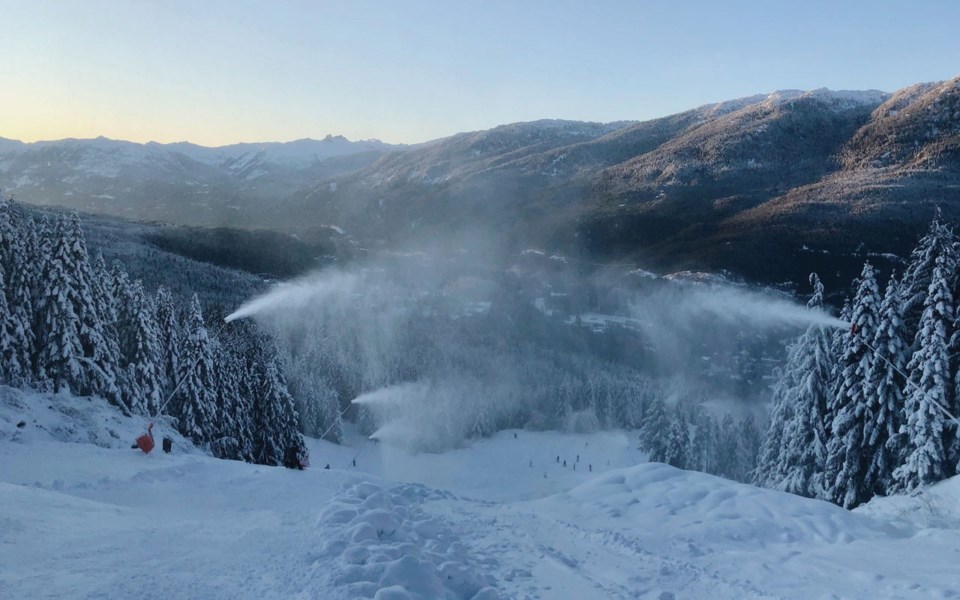Are we having fun on the mountain yet?
After morphing, as a friend put it, from "ribbons of death" to "not bad" and even, on occasion, "enjoyable," of course we are. Given a climate that's shifting winter later and later, however, we're still in that portion known as "early-season conditions," with no end in sight. And so there's something you need to keep in mind: you are not here to ski yet, you are here to survive. To help you navigate this now extended warm-up period, here are some helpful tips.
1. Give plaudits
When snow doesn't come when it should, it's difficult for everyone in a ski town. Certainly ski bums are choked about the lack of riding and, along with business owners, anxious over their jobs. But no single entity is more under the gun than the hill itself. With locals champing at the bit and vacationers arriving in droves, pressure to get something open is a very real challenge.
To that end, the crew at Whistler Blackcomb did a truly impressive job of snowmaking and coverage-extension before opening day and beyond. Throughout those first few trying weeks, WB deserves massive credit for every turn made. And now—with help from the town's populous Death Before Download squad of skiers and boarders compressing Mother Nature's meagre rations on other runs—WB has followed with an amazing job of grooming some of these out.
Message: given the weather to date, give thanks for how good the skiing is.
2. Learn to read
"Sign, sign, everywhere a sign," goes the song. But unlike the next line, signs on WB aren't "blockin' out the scenery, breaking my mind." In fact, they're there to help. Which is why it's odd so many skiers ignore them in early season.
Signs about conditions are key—you don't want to fly off a run at top speed to find yourself bouncing through some boneyard. But signs concerned with traffic management are even more critical in a low-snow year. "Merge" isn't hard to figure out (though I did meet an American who thought it was a French word—mergé—and puzzled over its disposition), but too many treat it like a yellow light they have to beat. Likewise, though even a five-year-old understands the meaning of S-L-O-W, this combination of letters seems to engender the opposite reaction in some adults—an attempt, one imagines, by the self-entitled to exit the Slow Zone as quickly as possible, an indictment of the low intelligence such calculus reflects. With the inevitable traffic chokes of early season, more—not less—vigilance of speed is required.
Finally, signs visible from certain lifts extoll users to make a plan for offloading with their seatmates. This may seem superfluous or unnecessary to seasoned skiers, but you ignore it at the peril of Warren Miller-style crashes and ligament-tearing pile-ups.
Message: do have a plan, and share it.
3. Learn to Count
Not knowing how to unload a lift is perhaps symptomatic of those who have no idea how to load one.
When it comes to innovation in ski-area infrastructure, Europe is usually ahead of the global ski diaspora it spawned. After sweeping the motherland, the first six-pack lift in North America was installed in Quebec in 1991. Though its proliferation didn't take hold here until the new millennium, it can now be referred to as ubiquitous. That means skiers the world over have had decades to get used to the concept of six abreast. And yet, ability to organize themselves to board a six-pack seems orders of magnitude worse than their already sketchy skills with a quad.
While the very sight of a six-pack seems cause for instant mathematical meltdown, certain constellations of circumstance are particularly irksome. For instance, during early season there is no sign of intelligent life at the Emerald Chair. Design flaws aside, and with sympathy to the brave lifties trying to prevent catastrophic death among the lobotomized hordes, skiers appear pathologically incapable of knowing how many they are before the singles-line merger, and then filling out their group.
Even for those who do pull off a nascent miracle of organization, it often crumbles at the gate because of idiots ahead who either can't count or are busy finishing an Instagram post, leading to a ripple effect of half-full chairs.
Message: whether quad or six-pack, group up before the gate and stay together.
4. Dumb it Down
Highway 99 has a variable speed corridor in which you adjust your driving to the conditions. It makes similar sense to keep your skiing simpler and slower when conditions are icy, variable or otherwise challenging. Look ahead. Look behind (especially heelside-turning snowboarders). Patience is a virtue everywhere, but particularly when it comes to skiing. And unless you're in a hurry to hurt yourself, don't go nuts when the snow inevitably makes it possible to ski on more of the mountain—it will fill in eventually.
Message: take it easy.
5. Smarten Up
Probably the best thing you ever learned as a skier and didn't realize it, was to pay attention—to the terrain, the surface, fellow skiers, changing hazards.
Message: put your mind in early season gear until it makes sense to shift.
Leslie Anthony is a Whistler-based author, editor, biologist and bon vivant who has never met a mountain he didn't like.




